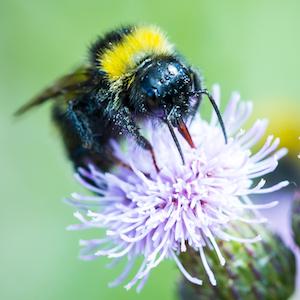Like GMOs and vaccines, misinformation is rife on the topic of bees.
Fearmongers warn of a coming "Beepocalypse." The media narrative is that bees are dying, humans are responsible, and if bees go extinct, many of our favorite foods will disappear and humans will starve to death. That's a gross exaggeration.
In reality, the western honey bee (a.k.a., European honey bee), which does much of the heavy lifting in regard to crop pollination, is doing just fine. Though there is evidence that some wild bee populations are declining, keep in mind that there are about 20,000 bee species, only a fraction of which contribute meaningfully to crop pollination. A paper published in Nature Communications underscores that latter point:
First, few species are needed to provide ecosystem services, with almost 80% of the crop pollination provided by only 2% of bee species. Second, the species currently contributing most to pollination service delivery are generally regionally common species, whereas threatened species contribute little, particularly in the most agriculturally productive areas.
In other words, commonly found bees do most of the pollination, while endangered bee species aren't contributing much to agriculture. If they went extinct, it would be a sad (and perhaps preventable) loss to biodiversity, but hardly an ecological catastrophe.
Besides, even if the very worst were to come true and all bees vanished overnight -- a scenario so outlandish as to be laughable -- society would not face an insurmountable problem: The Genetic Literacy Project explains that bees are responsible for about 7% of our food supply. That's a substantial portion; however, a bee extinction would not trigger civilizational collapse.
Just How Busy Are the Little Bees?
In order to have sane, evidence-based conversations on topics like bees, we need to collect as much data as possible. We all know that honey bees are important, but it would be far more useful to put a numerical value on their importance. So, researchers set about doing just that.
The team, led by Keng-Lou James Hung, collected data from the published literature on 80 different plant-pollinator interaction networks across the world. They only examined natural habitats (not farmland), and they excluded any natural areas thought to be too close to places that might house domesticated bees for agricultural pollination. The data, which probably underestimate the true importance of the western honey bee in natural habitats, are visualized in the graphic below:

On average, across natural habitats all over the world, the western honey bee was the most common pollinator, responsible for 13% of flower visits. The researchers also found that 5% of the plant species they studied were exclusively visited by the western honey bee.
Fear not, bee lovers. The busy little bees are keeping busy.
Source: Keng-Lou James Hung, Jennifer M. Kingston, Matthias Albrecht, David A. Holway, Joshua R. Kohn. "The worldwide importance of honey bees as pollinators in natural habitats." Proc Royal Soc B 285: 20172140. Published: 10-January-2018. DOI: 10.1098/rspb.2017.2140




